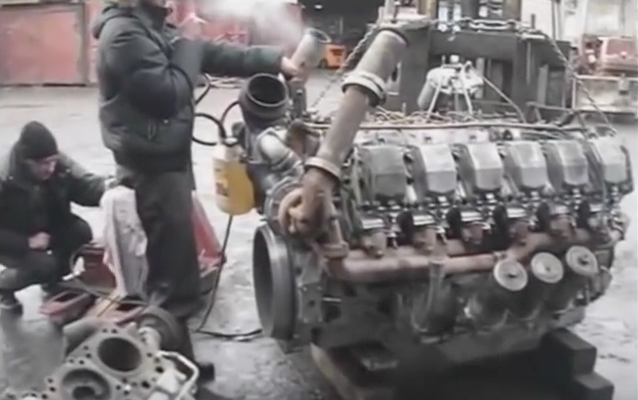The first V-type engine (a 2-cylinder vee twin) was built in 1889 by Daimler, to a design by Wilhelm Maybach. By 1903 V8 engines were being produced for motor boat racing by the Société Antoinette to designs by Léon Levavasseur, building on experience gained with in-line four-cylinder engines. In 1904, the Putney Motor Works completed a new V12 marine racing engine — the first V12 engine produced for any purpose.[2] Known as the ‘Craig-Dörwald’ engine after Putney’s founding partners, the engine mounted pairs of L-head cylinders at a 90 degree included angle on an aluminum crankcase, using the same cylinder pairs that powered the company’s standard 2-cylinder car.
A single camshaft mounted in the central vee operated the valves directly. As in many marine engines, the camshaft could be slid longitudinally to engage a second set of cams, giving valve timing that reversed the engine’s rotation to achieve astern propulsion. “Starting is by pumping a charge into each cylinder and switching on the trembler coils. A sliding camshaft gave direct reversing. The camshaft has fluted webs and main bearings in graduated thickness from the largest at the flywheel end.”[3] Displacing 1,119.9 cuin (18,352 cc) (bore and stroke of 4.875″ x 5″ (123.8 x 127 mm)), the engine weighed 950 pounds (430 kg) and developed 150 bhp (110 kW). Little is known of the engine’s achievements in the 40-foot hull for which it was intended, while a scheme to use the engine to power heavy freight vehicles never came to fruition.[2] One V12 Dörwald marine engine was found still running in a Hong Kong junk in the late-1960s.
Two more V12s appeared in the 1909-10 motor boat racing season. The Lamb Boat & Engine Company of Clinton, Iowa built a 1,558.6 cuin (25,541 cc (5.25″ x 6″ (133.4 x 152.4 mm)) engine for the company’s 32-foot Lamb IV. It weighed in at 2,114 pounds (959 kg). No weight is known for the massive 3,463.6 cuin (56,758 cc) (7″ x 7.5” (177.8 x 190.5 mm)) F-head engine built by the Orleans Motor Company. Output is quoted as “nearly 400 bhp (300 kW)”.
By 1914, when Panhard built two 2,356.2 cuin (38,611 cc) (5″ x 10″ (127 x 254 mm)) engines with four-valve cylinder heads the V12 was well established in motor boat racing.[2]
In automobiles, V12 engines have not been common due to their complexity and cost. They are used almost exclusively in expensive sports and luxury cars because of their power, smoother operation and distinctive sound.

